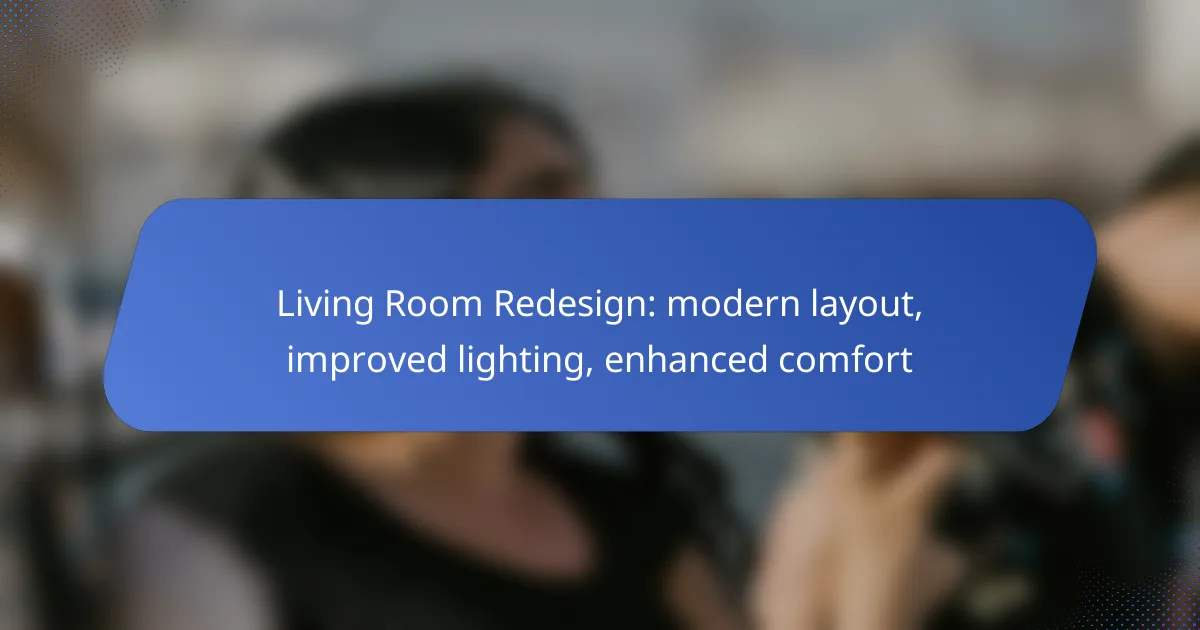Redesigning your living room can transform it into a modern, functional space that enhances both comfort and style. By optimizing the layout for natural light and incorporating layered lighting solutions, you can create an inviting atmosphere perfect for relaxation and socializing. Additionally, selecting the right furniture and textiles will further elevate the comfort level, making your living room a true sanctuary in your home.

How to redesign a living room layout in London?
Redesigning a living room layout in London involves optimizing space for modern living while enhancing comfort and functionality. Consider factors such as natural light, furniture arrangement, and creating distinct areas for various activities.
Open floor plan advantages
An open floor plan can significantly enhance the feeling of space in a London living room. This layout allows for better flow between areas, making the room feel larger and more inviting.
Additionally, open floor plans facilitate social interactions, as they enable easy communication between the kitchen, dining, and living areas. This design is particularly beneficial in smaller flats where maximizing space is essential.
Furniture arrangement tips
When arranging furniture, prioritize functionality and comfort. Start by placing larger pieces, such as sofas and coffee tables, to create a natural focal point. Ensure there is enough space for movement, ideally leaving at least 60 cm between pieces.
Consider using multi-functional furniture, such as ottomans with storage or convertible sofas, to maximize utility. Avoid overcrowding the space; instead, aim for a balanced layout that encourages relaxation and socializing.
Creating functional zones
To create functional zones in your living room, identify specific activities you want to accommodate, such as reading, watching TV, or entertaining guests. Use rugs, lighting, and furniture placement to delineate these areas.
For example, position a comfortable chair and a small side table in a corner for a reading nook, while a sofa and coffee table can define the entertainment area. This approach not only enhances usability but also adds visual interest to the space.

What lighting improvements can enhance a living room?
Enhancing lighting in a living room can significantly improve its ambiance, functionality, and comfort. Key improvements include implementing layered lighting, selecting modern fixtures, and optimizing natural light to create a warm and inviting space.
Layered lighting techniques
Layered lighting involves combining different types of lighting to create depth and versatility in a room. This typically includes ambient lighting for overall illumination, task lighting for specific activities, and accent lighting to highlight features or decor.
To effectively layer lighting, consider using ceiling fixtures for ambient light, table lamps or floor lamps for task lighting, and wall sconces or spotlights for accent lighting. This approach allows you to adjust the mood and functionality of the living room based on the time of day or activity.
Best light fixtures for modern spaces
For modern living rooms, choose fixtures that complement a clean and minimalist aesthetic. Popular options include sleek pendant lights, geometric chandeliers, and LED recessed lighting, which provide both style and energy efficiency.
When selecting fixtures, ensure they are proportionate to the room size. For example, larger fixtures can serve as focal points in spacious areas, while smaller, more understated options work well in compact settings. Aim for a mix of styles to maintain visual interest.
Natural light optimization
Optimizing natural light can enhance the overall brightness and mood of a living room. Start by using sheer curtains or blinds that allow sunlight to filter in while maintaining privacy. Position mirrors strategically to reflect light and create an illusion of more space.
Consider the layout of your living room; placing furniture away from windows can maximize light exposure. Additionally, using light-colored paint on walls and ceilings can help bounce natural light around the room, making it feel more open and airy.

How to increase comfort in your living room?
To increase comfort in your living room, focus on selecting appropriate furniture, incorporating soft textiles, and managing temperature effectively. These elements work together to create a welcoming and relaxing environment.
Choosing the right furniture
Selecting the right furniture is crucial for enhancing comfort in your living room. Opt for pieces that provide adequate support and are proportionate to the space. Sofas with deep seating and ergonomic chairs can significantly improve relaxation.
Consider modular furniture that can be rearranged to suit different activities, such as entertaining guests or enjoying family movie nights. Look for durable materials that withstand daily use while maintaining comfort.
Textiles and materials for comfort
Textiles play a vital role in creating a cozy atmosphere. Use soft fabrics like cotton, linen, or velvet for cushions, throws, and curtains to add warmth and texture. Layering different materials can enhance visual appeal and comfort.
Incorporate rugs to define spaces and provide warmth underfoot. Choose rugs that are easy to clean and fit the overall color scheme of your living room. Aim for a balance between style and practicality.
Temperature control solutions
Effective temperature control is essential for comfort in your living room. Consider using energy-efficient heating and cooling systems to maintain a pleasant environment year-round. Programmable thermostats can help regulate temperature based on your schedule.
In warmer climates, ceiling fans can improve air circulation, while in cooler areas, adding insulation can keep the space warm. Use curtains or blinds to block out heat during summer and retain warmth in winter, ensuring a comfortable living space throughout the year.

What are the costs associated with living room redesign?
The costs of a living room redesign can vary significantly based on factors like the scope of the project, materials chosen, and whether you opt for professional help or take a DIY approach. Generally, you can expect to spend anywhere from a few hundred to several thousand dollars, depending on your choices.
Budgeting for furniture and decor
When budgeting for furniture and decor, consider the quality and style you desire. Basic furniture pieces can start at a few hundred dollars, while high-end options may run into the thousands. Aim for a balanced mix of affordability and quality to enhance comfort without overspending.
Additionally, factor in decor items such as rugs, curtains, and artwork. These can range from budget-friendly finds at local stores to custom pieces that elevate the space. A good rule of thumb is to allocate about 20-30% of your total redesign budget for decor.
Cost of professional redesign services
Hiring a professional designer can streamline your living room redesign but comes at a cost. On average, design services can range from $50 to $200 per hour, or you might pay a flat fee that could be several thousand dollars depending on the project’s complexity. This investment often results in a more cohesive and functional space.
Be sure to clarify what services are included in the fee, such as consultations, project management, and sourcing materials. Understanding these details can help you assess the overall value of hiring a professional.
DIY vs. hiring a designer
Choosing between DIY and hiring a designer depends on your budget, skills, and time availability. DIY projects can save money, with costs primarily for materials and tools, but they require significant time and effort. If you have a clear vision and enjoy hands-on work, this can be a rewarding option.
On the other hand, hiring a designer can lead to a more polished outcome, especially if you’re unsure about layout or color choices. Weigh the potential benefits of professional insight against the costs to determine the best path for your living room redesign.

What trends are shaping modern living room designs?
Modern living room designs are increasingly influenced by sustainability, technology, and minimalist aesthetics. These trends focus on creating functional, comfortable spaces that reflect contemporary lifestyles while being environmentally conscious.
Sustainable materials in design
Sustainable materials are becoming a key component in modern living room designs, emphasizing eco-friendliness and durability. Options like reclaimed wood, bamboo, and recycled metals not only reduce environmental impact but also add unique character to the space.
When selecting materials, consider certifications such as FSC (Forest Stewardship Council) for wood products or GREENGUARD for low-emission furnishings. These certifications ensure that the materials meet stringent environmental standards, promoting healthier indoor air quality.
Smart home technology integration
Integrating smart home technology into living rooms enhances convenience and comfort. Features like smart lighting, automated window treatments, and voice-controlled entertainment systems allow for seamless control of the environment, improving both functionality and ambiance.
When implementing smart technology, prioritize compatibility with existing devices and consider user-friendly interfaces. For example, using a single app to control multiple systems can simplify the user experience and reduce frustration.
Minimalist design principles
Minimalist design principles focus on simplicity and functionality, creating uncluttered living spaces that promote relaxation. This approach often involves a neutral color palette, streamlined furniture, and a limited number of decorative elements, allowing for a more serene atmosphere.
To achieve a minimalist look, declutter your living room by keeping only essential items and choosing multifunctional furniture, such as a coffee table with storage. This not only maximizes space but also enhances the overall aesthetic by reducing visual noise.

How to choose the right color palette for a living room?
Choosing the right color palette for a living room involves understanding the mood you want to create and how colors interact with each other. Consider factors like natural light, existing furniture, and personal preferences to select colors that enhance the space.
Popular color trends in 2023
This year, earthy tones and muted colors are gaining popularity, reflecting a desire for comfort and connection to nature. Shades like terracotta, sage green, and soft beige create a warm, inviting atmosphere.
Additionally, bold accents are being used to add personality to living rooms. Deep blues, rich greens, and vibrant yellows can serve as focal points when paired with neutral backgrounds, allowing for a balanced yet dynamic look.
When selecting colors, consider testing samples on your walls to see how they look at different times of the day. This helps ensure that the chosen palette works well with the room’s lighting and overall design.










